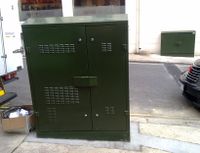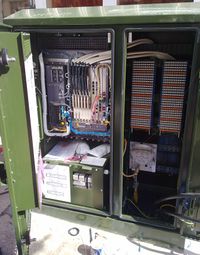Proposal:Telecom local loop
| The Feature Page for this approved proposal is located at Tag:telecom=exchange |
| Telecom local loop | |
|---|---|
| Proposal status: | Approved (active) |
| Proposed by: | ZZ29 |
| Tagging: | telecom=* |
| Applies to: | |
| Definition: | Introducing new values to depict telecom local loops, with some keys to map this network in a consistent way. |
| Statistics: |
|
| Draft started: | 2015-02-15 |
| RFC start: | 2018-06-09 |
| Vote start: | 2018-10-13 |
| Vote end: | 2018-10-27 |
Rationale
Telecom local loops are the last-mile networks reaching subscribers to connect them to their provider service equipments. A lot of cabling, going from telecom exchanges to houses and buildings, is installed in underground pipes or on poles when overhead. Street cabinets can be used for cross-connection at mid-distance.
It may be a great benefit for OSM to setup tagging to describe visible cables and cabinets in the street. This will improve pavement accessibility mapping, telecom infrastructure knowledge and cutting-edge Fibre To The House networks rollout.
Currently, some features are mapped with inappropriate tagging which clutter the map a bit. This proposal will solve some issues about this too.
Here are some definitions to have in mind :
- Exchange (722-06-05) : A place (i.e physically a building or a cabinet) containing several services equipments including telecom switches, transmission and amplification equipment, main and/or secondary distribution frames. It connects local loops (subscribers side) to backbone and long distance networks.
- Local loop (721-16-04) : A physical set of cables connecting subscribers to multiplexers or switches in the exchange building. It represents the last mile network.
- Main distribution frame (714-19-01) : An equipment inside the telecom exchange intended to make semi-permanent connections between lines coming from subscribers through local loop to service devices
- Connection point (722-12-18) : A place (i.e usually a cabinet in the street but can be a building too) containing equipment to connect incoming local loop lines to subscribers lines. They can be known as primary or secondary depending of the hierarchy of the network.
- Distribution point (722-12-19) : Final local loop point on the subscriber side. It connect public cables to private wires in households or buildings.
Proposal
It is proposed to use telecom=* key to map telecom copper, fibre and coaxial local loops networks. It will act as the main placeholder for values regarding cabling, dedicated technical buildings and eventually devices if applicable.
telecom=* is expected to document many telecommunication features for both fixed and mobile networks. This proposal only covers a few possible values for this key.
The proposal will rely on existing and defined man_made=street_cabinet and describe more precisely the different kinds of networks components and functions. Network mediums will also be introduced with the help of telecom:medium=*
- telecom:medium=copper for twisted copper pair networks (old telephone service)
- telecom:medium=fibre for "fibre to the X" networks
- telecom:medium=coaxial for coaxial cable networks (television service)
Tagging of each features is detailed below. This is certainly a bit complex and strongly technical document to read. Wikipedia links are given as often as possible. This proposal is also a good opportunity to provide a strong frame for such a particular set of features as to not clutter other keys on the map.
How to map
"Telephone exchanges" and "connection points" are logical network elements. They are usually hosted in dedicated buildings or street cabinets. However, some of these elements can sometimes be found together in the same physical place, or even in buildings shared with other kinds of infrastructure.
When a building hosts only a single network element (exchange, connection point…), just draw an area around the building and use the tags defined below directly on the building.
Whenever several network elements cohabit in the same building, please draw the building as an area, but then put telecom=* tags on separate OSM nodes inside. For instance, when a telephone exchange is known to host both copper and fibre service, two OSM nodes should be used with telecom:medium=copper on the first one and telecom:medium=fibre on the second one.
This distinction will allow to precisely follow the life cycle of both technologies, without any interference coming from the fact that they can be hosted in the same physical location.
Tagging
Telecom exchange
A telephone exchange is a building, a part of a building or in some countries a street cabinet which connects a subscriber's home with the service provider devices. A lot of switching equipments are located in exchanges, including the Main Distribution Frame which is actually inside the building (and shouldn't be confused with the real building). This document means that exchanges can be hosted in street cabinets for sake of space savings, which doesn't imply that all telecom street cabinets are actual exchanges. Especially connection points shouldn't be confused with real telecom exchanges.
| Key | Value | Description | Use |
|---|---|---|---|
| telecom | exchange | The exchange building should be mapped as |
mandatory |
| building | service | When located in a dedicated building. | optional |
| building:prefabricated | yes | When the telecom exchange is located inside a prefabricated building | optional |
| man_made | street_cabinet | When the telephone exchange is in a street cabinet. | optional |
| street_cabinet | telecom | required with man_made=street_cabinet | |
| telecom:medium | <medium type> | The type of local loop it is used to. See below for possible values. | recommended |
| operator | <operator> | The name of the company that operates the central. | recommended |
| owner | <owner> | The name of the organization which has the ownership of the central (State or local administritive organisation for example) | optional |
| ref | <reference> | Telephone exchange reference if applicable. See ref:FR:PTT=* or ref:FR:Orange=* for French example | recommended |
Local loops medium
This key describes the medium on the local loop side. For instance, a telephone exchange for xDSL won't have the fibre value, even though it may be connected to a backbone network with optical fibre.
| Key | Value | Comment |
|---|---|---|
| telecom:medium | copper | When subscribers reach the telephone exchange devices with xDSL (called DSLAM) or plain old telephone technologies. Typically for xDSL service. |
| telecom:medium | fibre | When subscribers reach the telephone exchange devices with fibre (called OLT). Typically for FTTH or FTTO service. |
| telecom:medium | coaxial | When subscribers reach the telephone exchange devices (called CMTS) with coaxial cables. Typically for FTTB or FTTLa service. |
Standalone service devices
Service devices are active equipment which deliver service to connected customers. It can be for instance a DSLAM, a telephone switch, or more recently an OLT for optical networks. It excludes amplifiers or repeaters installed along local loops or long distance lines.
This proposal isn't intended to fully define how service devices work, since it's a complex topic and not so relevant for OSM.
Such service devices are usually installed in telecom exchange buildings, but they can also sometimes be installed outdoor, in standalone street cabinets. This may be because of a lack of physical space in exchange buildings, or to increase data rates in suburbs areas by shortening the length of the copper local loop.
Those cabinets must only contain service devices without a distribution frame, otherwise they turn into an actual telecom=exchange in a cabinet. Furthermore, a service device cabinet does not create a new local loop: it simply serves a subset of customers on an existing local loop, and connects back to an upstream telecom exchange building.
| Key | Value | Description | Use |
|---|---|---|---|
| man_made | street_cabinet | mandatory | |
| street_cabinet | telecom | mandatory | |
| telecom | service_device | mandatory | |
| telecom:medium | copper or fibre mainly | Depend on which technology the service is delivered to customers | mandatory |
| operator | <operator> | The name of the company that operates the cabinet. | recommended |
| owner | <owner> | The name of the organization which has the ownership of the cabinet (State or local administrative organization for example) | recommended |
| ref | <reference> | Device cabinet (several devices can be in a single cabinet) reference as seen in situation | recommended |
Connection points
Connection points allow networks operators to manage wiring resources according to subscribers needs and network availability. They allow to reduce the amount of cable needed to reach telephone exchanges, as all subscribers aren't connected at a given date. Patch panels are used to connect and disconnect subscribers as they subscribe or leave the network. That's why anyone is able to see technicians working next to them often as network subscribers churn can be pretty intense.
Connection points can either be located in the street in a man_made=street_cabinet, or directly in the basement of a residential building.
Some local loops can have a hierarchy of connection points: there may be several connection points chained to one another between the telephone exchange and the subscriber. This piece of information can be hard to obtain, but a dedicated connection_point=* key is intended to add it in OSM if known.
| Key | Value | Description | Use |
|---|---|---|---|
| telecom | connection_point | It's a local loop connection point | mandatory |
| telecom:medium | copper, fibre or coaxial | The local loop medium the connection point is hosting | recommended |
| operator | <operator> | The name of the company that operates the connection point. | recommended |
| connection_point | primary, secondary, tertiary... | Connection point hierarchy level. A secondary connection point is linked to a primary one which is linked to telephone exchange and so on | optional |
| man_made | street_cabinet | Can be used if the connection point is in a cabinet | optional |
| street_cabinet | telecom | The cabinet is dedicated to telecom networking | required with man_made=street_cabinet |
| ref | <reference> | Connection point reference if applicable. See ref:FR:PTT=* or ref:FR:Orange=* for French example | recommended |
Edition management
Keys to be replaced
| Obsolete tag | Usage volumetry | Used for ? | New tag(s) to use |
|---|---|---|---|
| man_made=MDF | 6 979 on 2018-06-02 | Telephone exchange building. MDF is only a device in the building | telecom=exchange |
| man_made=telephone_exchange | 307 on 2018-06-02 | Telephone exchange building. man_made=* is a too broad key and telephone word may confuse some mappers (while it's properly understood by experts) | telecom=exchange |
| telecom=central_office | 2442 on 2018-06-20 | Central office was introduced by Bell, mainly in North America and OSM terminology have to be taken from British English where Exchange is a more used word for places where telecom services are connected to local loops through distribution frames | telecom=exchange |
| telecom=outdoor_dslam | 97 on 2018-08-05 | Any feature referring to outside device bringing service to a subscriber line (then, no amplifiers, no repeaters). Especially not inside a proper telecom exchange | telecom=service_device |
| telecom=street_cabinet | 247 on 2018-08-05 | A cabinet installed in the street for cable management, subscribers connections or any active device outside of telecom exchange | man_made=street_cabinet + street_cabinet=telecom |
| telecom=connection | 106 on 2018-08-05 | An enclosed connection point in the local loop, for subscribers connection or cable management | telecom=connection_point |
Affected pages
- Edit telecom=* key pages
- Create telecom=exchange, telecom=connection_point, telecom=service_device
- Create connection_point=*
- Create telecom:medium=*
- Edit man_made=MDF and set it to be replaced
Examples
Telecom exchanges and outdoor dslams
| Photo | Tagging | Note |
|---|---|---|
 |
This is a small dedicated technical building hosting a main distribution frame to connect subscribers to a telephone exchange. This is a telephone exchange. | |
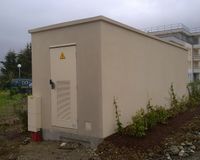 |
building=service
|
This is a movable and prefabricated service building hosting copper local loops equipments (including old telephone service). Subscribers are connected to it through a local copper network.
|
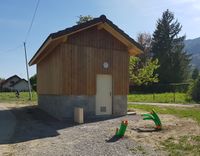 |
building=service
|
This is a permanent service building hosting fibre local loops equipments. Subscribers are connected to it through a local fibre network (explained in local news and in place billboards announcing recent fibre availability). In France, green ducts means an underground network is installed which confirm this is a telecom building. |
 |
man_made=street_cabinet
|
As explained on left cabinet doors, this is an actual telecom exchange hosted in a street cabinet. French telecom regulation rules let us know this is intended to bring broadband xDSL services on rural copper landlines. |
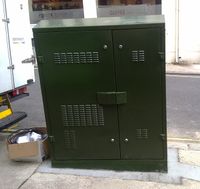 |
man_made=street_cabinet
|
Such cabinets are usual in England, operated by openreach and installed next to local loop connection points. They host dslam nearer from subscribers as to increase their transmission rate over xDSL connections. |
Connection points
| Photo | Tagging | Note |
|---|---|---|
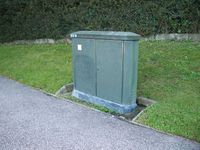 |
man_made=street_cabinet
|
This is a really common telecom cabinet in France acting as a primary connection point on all legacy 22 000 telephone/xdsl copper local loops. |
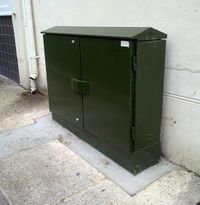 |
man_made=street_cabinet
|
A really common thing in England, a primary connection point operated by Openreach in a usual green street cabinet |
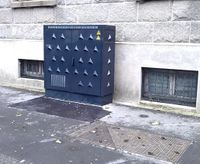 |
man_made=street_cabinet
|
A newer connection point cabinet in France for fibre to subscribers networks. No copper in it, only fibre. We know it's fibre as an ISO 7010-W004 sign is displayed on the cabinet. |
Voting
Voting on this proposal has been closed.
The result is accepted with 27 votes for.
 I approve this proposal. --EneaSuper (talk) 08:36, 22 October 2018 (UTC)
I approve this proposal. --EneaSuper (talk) 08:36, 22 October 2018 (UTC) I approve this proposal. --Don-vip (talk) 14:31, 13 October 2018 (UTC)
I approve this proposal. --Don-vip (talk) 14:31, 13 October 2018 (UTC) I approve this proposal. --Tohaklim (talk) 15:14, 13 October 2018 (UTC)
I approve this proposal. --Tohaklim (talk) 15:14, 13 October 2018 (UTC) I approve this proposal. --Gendy54 (talk) 16:02, 13 October 2018 (UTC)
I approve this proposal. --Gendy54 (talk) 16:02, 13 October 2018 (UTC) I approve this proposal. Fanfouer (talk) 17:48, 13 October 2018 (UTC)
I approve this proposal. Fanfouer (talk) 17:48, 13 October 2018 (UTC) I approve this proposal. --Processus42 (talk) 22:12, 13 October 2018 (UTC)
I approve this proposal. --Processus42 (talk) 22:12, 13 October 2018 (UTC) I approve this proposal. --Axelos (talk) 07:26, 14 October 2018 (UTC)
I approve this proposal. --Axelos (talk) 07:26, 14 October 2018 (UTC) I approve this proposal. --Stevea (talk) 08:58, 14 October 2018 (UTC)
I approve this proposal. --Stevea (talk) 08:58, 14 October 2018 (UTC) I approve this proposal. --SyrusMpl (talk) 14:19, 14 October 2018 (UTC)
I approve this proposal. --SyrusMpl (talk) 14:19, 14 October 2018 (UTC) I approve this proposal. --ZZ29 (talk) 14:34, 14 October 2018 (UTC)
I approve this proposal. --ZZ29 (talk) 14:34, 14 October 2018 (UTC) I approve this proposal. --Anakil (talk) 21:23, 14 October 2018 (UTC)
I approve this proposal. --Anakil (talk) 21:23, 14 October 2018 (UTC) I approve this proposal. --Fizzie41 (talk) 04:39, 15 October 2018 (UTC)
I approve this proposal. --Fizzie41 (talk) 04:39, 15 October 2018 (UTC) I approve this proposal. --Rallysta74 (talk) 08:05, 15 October 2018 (UTC)
I approve this proposal. --Rallysta74 (talk) 08:05, 15 October 2018 (UTC) I approve this proposal. --Kazing (talk) 09:37, 15 October 2018 (UTC)
I approve this proposal. --Kazing (talk) 09:37, 15 October 2018 (UTC) I approve this proposal. --Atabaraud (talk) 12:29, 15 October 2018 (UTC)
I approve this proposal. --Atabaraud (talk) 12:29, 15 October 2018 (UTC) I approve this proposal. --Lmagreault (talk) 14:46, 15 October 2018 (UTC)
I approve this proposal. --Lmagreault (talk) 14:46, 15 October 2018 (UTC) I approve this proposal. --Severin (talk) 16:05, 15 October 2018 (UTC)
I approve this proposal. --Severin (talk) 16:05, 15 October 2018 (UTC) I approve this proposal. --Renecha (talk) 18:41, 15 October 2018 (UTC)
I approve this proposal. --Renecha (talk) 18:41, 15 October 2018 (UTC) I approve this proposal. --liotier (talk) 20:26, 15 October 2018 (UTC)
I approve this proposal. --liotier (talk) 20:26, 15 October 2018 (UTC) I approve this proposal. --Buchanan (talk) 15:27, 16 October 2018 (UTC)
I approve this proposal. --Buchanan (talk) 15:27, 16 October 2018 (UTC) I approve this proposal. The examples are also great. Please copy&paste some vital information into the final tables in the wiki about how to differentiate the various kinds of equipment for sure. --Bkil (talk) 16:59, 18 October 2018 (UTC)
I approve this proposal. The examples are also great. Please copy&paste some vital information into the final tables in the wiki about how to differentiate the various kinds of equipment for sure. --Bkil (talk) 16:59, 18 October 2018 (UTC) I approve this proposal. --Zorun (talk) 19:03, 18 October 2018 (UTC)
I approve this proposal. --Zorun (talk) 19:03, 18 October 2018 (UTC) I approve this proposal. --Kresp0 (talk) 12:30, 22 October 2018 (UTC)
I approve this proposal. --Kresp0 (talk) 12:30, 22 October 2018 (UTC) I approve this proposal. --tomtl (talk) 13:16, 22 October 2018 (UTC)
I approve this proposal. --tomtl (talk) 13:16, 22 October 2018 (UTC) I approve this proposal. --Lasing all day (talk) 14:45, 22 October 2018 (UTC)
I approve this proposal. --Lasing all day (talk) 14:45, 22 October 2018 (UTC) I approve this proposal. --Jotam (talk) 09:46, 25 October 2018 (UTC)
I approve this proposal. --Jotam (talk) 09:46, 25 October 2018 (UTC) I approve this proposal. although I do not think the building value for these must necessarily be "service", but this hasn't probably to be taken literally (the focus here is telco). --Dieterdreist (talk) 09:49, 25 October 2018 (UTC)
I approve this proposal. although I do not think the building value for these must necessarily be "service", but this hasn't probably to be taken literally (the focus here is telco). --Dieterdreist (talk) 09:49, 25 October 2018 (UTC)
